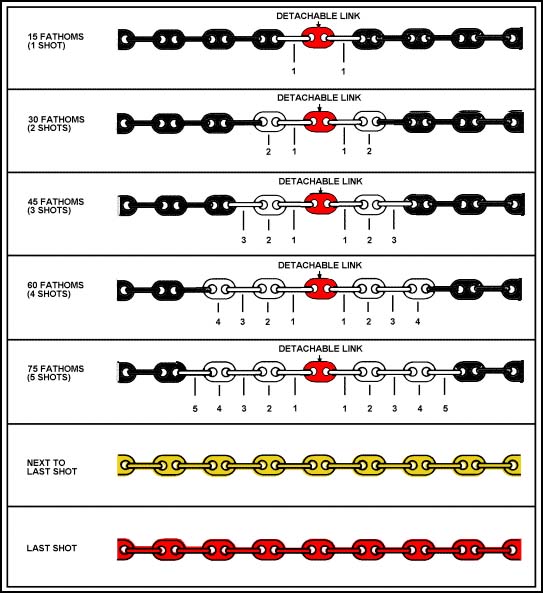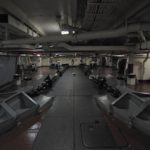This, in older ships, is where the anchor gets deployed and retracted.
–
Table of Contents:
- Introduction
- Notes
- Access
- Rules
- Special Features
- Conceptual Images
–
Introduction:
Like the terrestrial naval ships of old, TNH bolsters its ability to remain in a fixed stationary position with chain-linked, retractable anchors. Although TNH is capable of utilizing electromagnetic grapplers and gravity beams as fine as lasers, should these systems fail or prove unsuitable for any situation, TNH is able to fall back to its terrestrial-anchoring roots. In short, it can literally drop anchor and hover or float over any body of land or water.
–
Notes:
Anchor-chains are a vital part of mooring a ship to the bottom of the ocean. They are made up of 15-fathom (90-foot) lengths called shots, which are connected by detachable links. The unused portion of the chain is kept in a large compartment below-decks called the chain locker. When a ship anchors, the amount of chain that is put out, called the scope, is usually five to seven times the depth of the water. For example, if a ship is anchoring in 60 feet of water, it will use between 300 and 420 feet of chain.
Each ‘shot’ of chain (i.e. 15 fathoms or 90’) is indicated by the detachable link painted in red. The link(s) on either side of the detachable link will be marked white, with one white equaling the first shot, two whites the second, and so on, until you get to ‘the warning shot’ in (which is colored) all yellow, and ‘the final shot’ in all red.
The first link of an anchor chain is often indicated by white paint on the link and red paint on the connecting link. Anchor chains may also be marked with paint to indicate 25-foot sections:
- Red: 25 feet from the anchor
- White: 50 feet from the anchor
- Blue: 75 feet from the anchor
- Yellow/Golden: 100 feet from the anchor
On recreational (non-military) vessels, there is no required (links color-coding) standard, and various (color-coding) methods might be used depending the needs/preference of the owner.

Weight: >30,000 lbs. (by section; entire chain/system weighs hundreds of thousands of lbs.); 15 tons
Length: ~1,400′
dimensions of a single link: TBA (like a midsized to large dog) –reference: maker
This ship dwarfs aircraft carriers of the 20th and 21st centuries, so its anchor-chain is thicker, but its weight is comparable because 500 years in the future… stronger lighter materials/devices are now common.

–
Access:
Usually only sailors in the Deck department get to come in here, and only when they are trained and assigned to operate this particular vessel’s two types of anchors; the physical/normal one, and the tractor-beam ones.
–
Rules:
Crew in this room wear helmets (full head enclosure) / respirators, and there are automatic vents (for sucking out contaminated/unsafe air), both so that no one (in this room) breathes any fumes from paint or rust rubbed off during dropping or rewinding of the anchor chain.
–
Special Features:
Tractor-beams allow TNH to be its own tugboat.
So how would a ship “drop anchor” in Outer Space? It’s easier than it may seem at first; the ship just either:
- uses large-enough asteroids/derelicts to energy-anchor off of / to, or
- has its Navigation/Helm department use the least-moving stars or other coordinates/’landmarks’ (the Space-equivalent of landmarks; Space-marks)
–
–
Also see:
–


